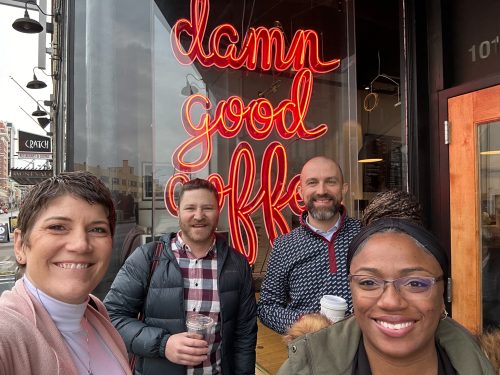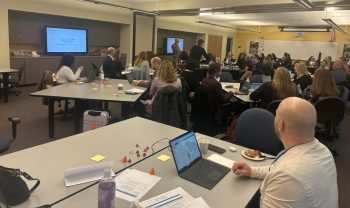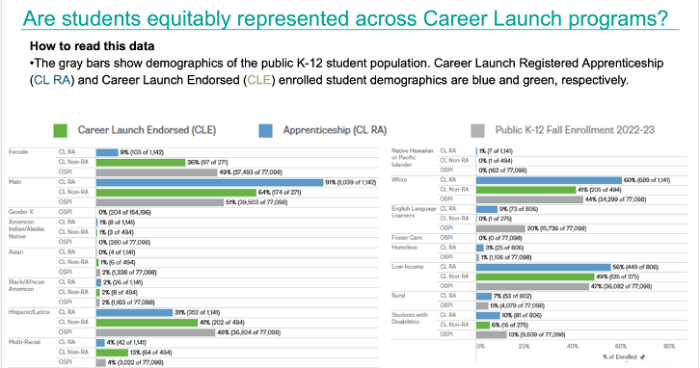Lighting up equitable career pathways: “The energy in the room is palpable”

Angie Mason-Smith, Washington STEM’s career pathways program director, recalled looking around the room at a recent gathering of Career Connect Washington (CCW) leadership and statewide partners in Spokane. “It was great to sit face-to-face and see everyone. The energy in the space is palpable.”
CCW’s stated goal is that race, income, geography, gender, citizenship status, and other demographics and student characteristics will no longer predict the outcomes of Washington’s students.
Their aim? To align regional strategies with statewide goals to increase opportunities for high school students to enter in-demand career pathways while satisfying industries’ need for skilled labor.
This means co-creating with industry partners more on-ramps to paid internships and apprenticeships, as well as developing upstream programs such as career exploration programs in middle school and career technical education and job shadowing during high school.
In order to do this, CCW is centering equity in how they build career pathway systems. Their stated goal is that race, income, geography, gender, citizenship status, and other demographics and student characteristics will no longer predict students’ education outcomes.

Mason-Smith said, “A system that doesn’t take into account the barriers students face–whether due to race or gender discrimination, or lack of resources in rural areas— will simply not reach all the students we need to reach. The purpose of this convening is to build relationships, share learnings and create a robust and equitable career pathways system. Our students deserve nothing less.”
Growing an existing system
Career Connect Washington was founded in 2018 to build-out job training programs that funnel high school graduates into high demand industries. The first-of-its-kind Spokane convening brought together leaders from Washington’s ten major employment sectors to help build these career pathways in advanced manufacturing and aerospace, education, finance, construction, health care, clean technology and energy, agriculture and natural resources, maritime, information technology and cybersecurity, and the life sciences.
Building a robust career pathways pipeline starts as early as middle school, when students start “career exploration” exercises. In high school, this is followed by “career prep”, which is often the career and technical education that leads to technical certifications or college credit. Then, as they prepare to graduate, they enter the “career launch” phase, which provides access to paid work experience, such as internships and apprenticeships in high-demand fields.

“When partners look at their programs’ enrollment data through a demographic lens, they discover that some groups are over- or under-represented in certain career pathways.”
-Angie Mason-Smith, Career Pathways Program Director
Prioritizing equity to meet industry labor demand
Washington STEM has partnered with CCW since its inception, providing technical data assistance to partners and hosting strategic conversations around equity. Mason-Smith said, “When partners look at their programs’ enrollment data through a demographic lens, they discover that some groups are over- or under-represented in certain career pathways.”
For instance, white, male students make up less than half (44%) of the K-12 population, but are nearly two-thirds (60%) of those enrolled in licensed, paid, apprenticeship programs. Compared to female enrollees (9%) they are vastly overrepresented in these paid positions that lead to good paying jobs.
She added, “Similarly, Latinos are almost half (48%) of the K-12 population, but only make up one-third of those enrolled in licensed apprenticeships.” Looking at enrollment through an equity and data lens makes clear that changes are needed in how students are recruited and retained.
Looking at enrollment through an equity and data lens makes clear that changes are needed in how students are recruited and retained.
Mason-Smith is confident this first of three, in-person convenings will give industry leaders and education partners time to network, build relationships, gain common understanding of goals and how they can stay true to value and outcomes, although their approaches may be different.
She said, “It’s a lot easier in these spaces together to see points of connection or exciting partnership. We all left feeling like our ‘to do’ lists were really long—but they are full of new opportunities that are actually going to make a difference.”